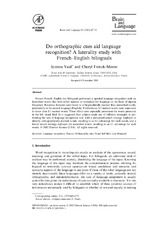| dc.creator | Vaid, Jyotsna | |
| dc.creator | Frenck-Mestre, Cheryl | |
| dc.date.accessioned | 2017-02-06T02:48:46Z | |
| dc.date.available | 2017-02-06T02:48:46Z | |
| dc.date.issued | 2002 | |
| dc.identifier.citation | Vaid, J. & Frenck-Mestre, C. (2002). Do orthographic cues aid language recognition? A laterality study with French-English bilinguals. Brain and Language, 82, 47-53. | en |
| dc.identifier.uri | https://hdl.handle.net/1969.1/158733 | |
| dc.description | This is a research study examining cues that bilinguals use to identify the language of visually presented words. | en |
| dc.description.abstract | Sixteen French–English late bilinguals performed a speeded language recognition task on lateralized words that were either marked or unmarked for language on the basis of digram frequency. Response latencies were faster to orthographically marked than unmarked words, particularly in the second language (English). Furthermore, L2 marked words were responded
to faster than L1 marked words. These effects were especially prominent for words presented in the left visual field. It is suggested that subjects made use of different strategies in performing the task of language recognition task, with a perceptual search strategy deployed to identify orthographically marked words, resulting in an L2 advantage for such words, and a
lexical search strategy deployed for unmarked words, resulting in an L1 advantage for such words. | en |
| dc.language.iso | en_US | |
| dc.subject | language recognition | en |
| dc.subject | digram | en |
| dc.subject | French-English bilinguals | en |
| dc.subject | orthographic cues | en |
| dc.subject | late bilinguals | en |
| dc.subject | visual half-field | en |
| dc.subject | laterality | en |
| dc.title | Do orthographic cues aid language recognition? A laterality study with French-English bilinguals. | en |
| dc.type | Article | en |
| local.department | Psychology | en |


